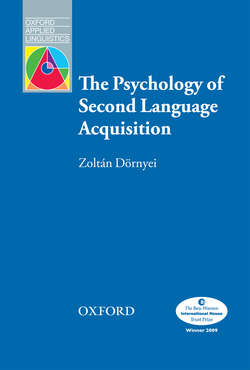Читать книгу The Psychology of Second Language Acquisition - Zoltan Dornyei - Страница 11
1
Introduction: mapping the terrain
Cognitive neuroscience
ОглавлениеKeeping up to date with cognitive neuroscience is much like surfing the Big Wave at Waikiki Beach. New findings keep rolling in and maintaining a stable balance is a big challenge. It is exciting, fun and, at times, a little bit scary.
(Baars and Gage 2007b: p. xiii)
The reason for talking about cognitive neuroscience separately from cognitive science is due to the unprecedented recent progress of neuroresearch as a result of major technological developments in neuroimaging techniques that have offered an entirely new window into the human mind, allowing the online study of the human brain while it is engaged in various cognitive tasks. As Nadel and Piattelli-Palmarini (2003: p. xxiv) summarize, the subsequent explosion of research on the brain mechanisms underlying human cognitive functions has been ‘nothing short of phenomenal’. This intoxicating new potential (and the concerns with it) will be described in depth in the next chapter, so let me here merely outline the main parameters of the discipline. According to Gazzaniga, Ivry, and Mangun (2002), the term ‘cognitive neuroscience’ was coined in a New York City taxi in the late 1970s to give name to a ‘new mission’ (p. 19) to examine how the brain enables the mind. Interestingly, one of the passengers in this famous taxi was the very George Miller who played a key role at the 1956 MIT conference that is usually seen as the starting point of cognitive science.
The missionary spirit has not subsided over the past three decades. The following extract from the Preface of Baars and Gage’s (2007b: p. xiii) recent summary of the field reflects the kind of excited confidence that accompanies successful expeditions:
[W]e are seeing a marriage of the cognitive and brain sciences, building on historic advances over the last few decades. Cognitive and perceptual mechanisms that were inferred from behaviour can now be observed more directly in the brain, using a variety of novel brain imaging methods. For the first time, we can observe the living brain in real time, doing what it has evolved to do over hundreds of millions of years. The result is astonishingly rich, combining psychology and biology, medicine, biochemistry and physics.
In the Preface of another best-selling textbook on cognitive neuroscience, Gazzaniga, Ivry, and Mangun (2002: p. xv) address one of the key questions of the field head on: ‘What constitutes the first principles that make cognitive neuroscience distinct from physiological psychology, neuroscience, cognitive psychology, or neuropsychology?’ The authors’ answer is that the characteristic feature of the new discipline is its well-balanced hybrid nature, integrating cognitive theory with neuropsychological and neuroscientific evidence, as well as computational techniques. This seems to be an idyllic ‘marriage of the cognitive and brain sciences’ (Baars and Gage 2007b: p. xiii).
Cognitive neuroscience and SLA
With language use being one of the most prominent human cognitive functions, a great deal of neuroscientific research has been directed at capturing ‘in vivo’ images of brain processes during a wide range of language tasks. Armed with powerful neuroimaging tools, several laboratories in the world have set out to map the language faculty in the human brain. (See Ch. 2 for more details.) Pulvemüller (2002: 9) justifies these neuropsychological efforts by pointing out that it is almost certain that language mechanisms in the brain are organized as nerve cells and their mutual connections, and a ‘realistic model of language, therefore, must specify the putative organic basis of language use and language comprehension in terms of neurons, neuronal connections, and neuron circuits’. Arguing in a similar vein, Lamb (1999) asserts that a realistic theory of language needs to go beyond merely accounting for various processes and patterns in the output of the human linguistic system (which, as we have seen, has been the traditional practice of linguistic analysis) by also providing ‘neurological plausibility’.
While most scholars would agree in principle with Pulvemüller and Lamb’s contention, Jacobs (2004) explains that a common objection to paying neuroscience more than mere lip service in language acquisition circles has been the claim that not enough is known about the brain to make significant contributions to our understanding of how language is acquired. In the light of the growing body of relevant research literature, however, this dismissive attitude is less and less tenable. (For a recent overview of the cognitive neuroscience of SLA, see Gullberg and Indefrey 2006.) While the picture emerging from cognitive neuroresearch on L1 and L2 issues has been admittedly rather ‘noisy’, we are getting an increasingly accurate sense of what kind of mental metaphors are simply not plausible in terms of their underlying neural foundation. This point is argued forcefully by Schumann (2004a) when he claims that in the twenty-first century we simply cannot afford not to impose certain neurobiological constraints on our conceptualization of language processes. The increasing amount of neuroscientific information available to SLA researchers about the bilingual brain (see e.g. Abutalebi, Cappa, and Perani 2005) offers sufficient munitions in this respect, and it is one of the main intentions of this book to provide the readers with enough background knowledge to be able to make use of this accumulating neuroscientific evidence.
